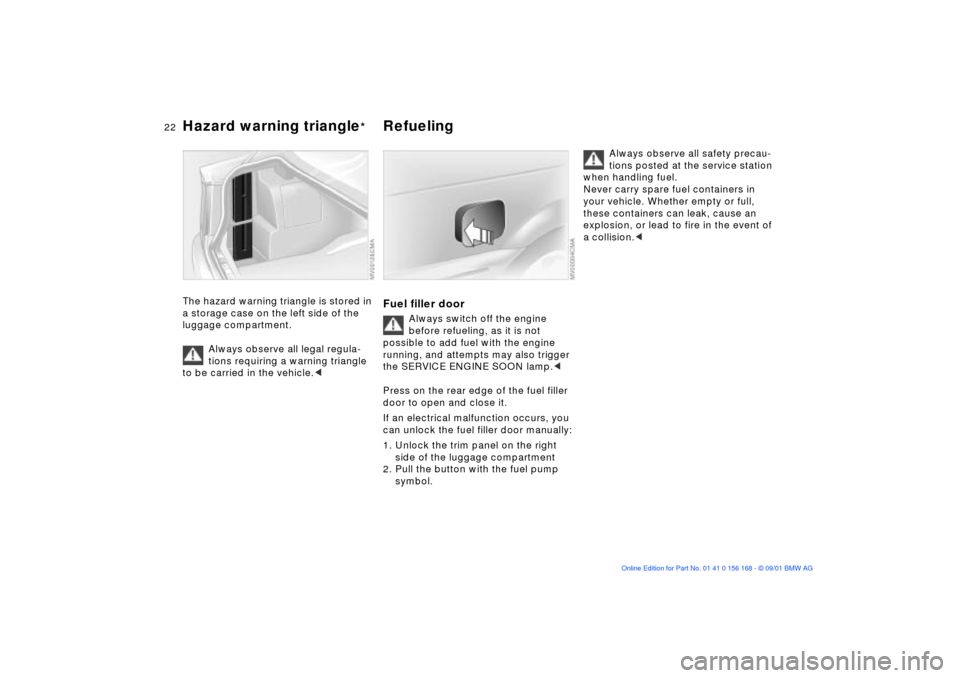Page 17 of 155

17n
OverviewControlsMaintenanceRepairsDataIndex
Indicator and warning lamps
Technology that monitors itself
The system runs an operational check
on the indicator and warning lamps
identified with the
l
symbol each time
you switch on the ignition. They each
light up once for different periods of
time.
If a fault should occur in one of these
systems, the corresponding lamp does
not go out after the engine is started, or
it lights up while the vehicle is moving.
You will see how to react to this below.
Red: stop immediately
Battery charge current
l
The battery is no longer being
charged. Indicates a defective
alternator drive belt or a problem with
the alternator's charge circuit. Please
contact the nearest BMW center.
If the drive belt is defective, stop
and switch off the engine immedi-
ately to prevent overheating and
serious engine damage. If the drive belt
is defective, increased steering effort is
also required.
<
Engine oil pressure
l
Stop the vehicle immediately
and switch off the engine.
Check the engine oil level; top off as
required. If the oil level is correct:
please contact the nearest BMW
center.
Do not continue driving, as the
engine could sustain serious
damage from inadequate lubrication.
<
Brake warning lamp
l
If the lamp comes on when the
parking brake is not engaged:
check the brake fluid level. Before
driving further, be sure to comply with
the instructions on pages 106 and 118
Brake warning lamp for Cana-
dian models.
Tire Pressure Monitor (RDC)/
Flat Tire Monitor
l
In addition, an acoustic signal is
sounded: a tire failure has occurred.
Reduce vehicle speed immediately and
stop the vehicle. Avoid hard brake
applications. As you steer the vehicle,
use caution and avoid overcorrecting.
For additional information: refer to
pages 78 and 80
Page 18 of 155

18n
Indicator and warning lamps
Red and yellow: continue driving
cautiously
The brake warning lamp comes
on together with the yellow indi-
cator lamps for ABS and
ASC+T/DSC:
The entire ABS, CBC, ASC+T/
DSC and
ADB/ADB-X/DBC
control system has failed.
Continue driving cautiously and
defensively. Avoid hard brake applica-
tions. Please have the system checked
by your BMW center as soon as
possible.
For additional information: refer to
pages 72, 73
CBC, ABS and ASC+T/DSC and
ADB/ADB-X/DBC indicator and
warning lamps for Canadian
models.
Red: an important reminder
Parking brake warning lamp
Comes on when the parking
brake is applied Ð an additional
acoustic signal sounds when starting
off.
For additional information: refer to
page 58
Parking brake warning lamp for
Canadian models.
Fasten safety belts
l
An acoustic warning also
sounds in some versions. Lights
up either for several seconds or until
the belt is engaged, depending upon
version.
For additional information on safety
belts: refer to page 45
Airbags
l
Please have the system
inspected by your BMW center.
For additional information: refer to
page 49
Orange: consult the nearest
BMW center
Automatic transmission
The transmission has
responded to a malfunction by
reverting to operation in its emergency
default program. Please consult the
nearest BMW center.
For additional information: refer to
page 59
Page 19 of 155

19n
OverviewControlsMaintenanceRepairsDataIndex
Indicator and warning lamps
Yellow: check as soon as possible
Antilock Brake System (ABS)
l
ABS has been deactivated in
response to system malfunction.
Conventional braking performance
remains available with no loss of effi-
ciency. Please have the system
inspected at your BMW center.
For additional information: refer to
page 105
ABS warning lamp for Canadian
models.
Engine oil level
Comes on while driving: the
engine oil level has fallen to the
absolute minimum; refill as soon as
possible. Do not drive more than
approx. 30 miles (50 km) until you do.
For additional information: refer to
page 115
Engine oil level
Comes on after the engine has
been shut off: add engine oil at
your earliest opportunity (next time you
stop to refuel). For additional informa-
tion: refer to page 115
Brake pads
l
Have the brake pads checked.
For additional information: refer
to page 106
Tire Pressure Monitor (RDC)/
Flat Tire Monitor
l
Check tire inflation pressures,
refer to pages 24, 78, 80
Automatic Stability Control plus
Traction (ASC+T)/Dynamic
Stability Control (DSC)
l
Indicator lamp flashes:
The system is actively regulating drive
torque and braking force.
The indicator lamp stays lit:
ASC+T has been switched off with the
button or it is defective, or the DSC has
been switched off, ADB is operational.
Please consult the nearest BMW center
in case of a malfunction.
For additional information: beginning on
page 72
BMW 325xi, 330xi:
DSC has been switched off manually or
there is a system malfunction.
ADB-X is operational in its standby
mode. If the warning lamp fails to go
out when you press the DSC button
again, this indicates a system malfunc-
tion affecting both DSC and ADB-X.
Please consult the nearest BMW
center.
For additional information: refer to
page 75
Indicator lamp for Automatic
Stability Control plus Traction
(ASC+T)/Dynamic Stability
Control (DSC) and brake warning
lamp
l
The indicator lamps remain on:
The DSC
and ADB/DBC have been
switched off with the button or are defec-
tive.
Please consult the nearest BMW center.
For additional information: refer to
page 73
BMW 325xi, 330xi:
DSC and ADB-X system malfunction.
There is no provision for deactivating
ADB-X.
Please consult the nearest BMW center.
For additional information: refer to
page 75
DSC and ADB indicator and
warning lamps for Canadian
models.
Dynamic Brake Control (DBC)
l
Malfunction in DBC system.
Conventional braking efficiency
is available and unrestricted.
Have the system repaired at your BMW
center as soon as possible. For addi-
tional information: refer to page 74
Page 20 of 155

20n
Indicator and warning lamps
Add washer fluid
The washer fluid is too low. Top
off the fluid at the earliest
opportunity. For additional information:
refer to page 114
SERVICE ENGINE SOON
l
If the indicator lamp comes on
either continuously or intermit-
tently, this indicates a fault in the emis-
sions-related electronic systems.
Although the vehicle remains opera-
tional, you should have the systems
checked at your BMW center at the
earliest possible opportunity.
For additional information: refer to
page 121.
SERVICE ENGINE SOON
warning lamp for Canadian
models.
Engine electronics
l
There is a fault in the electronic
engine-management system.
You can continue to drive with reduced
engine output or engine speed. Please
have the system inspected by your
BMW center.
Add coolant
The coolant level is too low. Add
coolant at the earliest opportu-
nity. For additional information: refer to
page 117
Green: for your information
Turn signal indicator
Flashes when the turn signals
are on.
Rapid flashing indicates a system
malfunction.
For additional information: refer to
page 61
Cruise control
Lights up when the cruise
control is activated: available for
operation via the multifunction steering
wheel.
For additional information: refer to
page 64
Fog lamps
Lights up whenever you switch
on the fog lamps.
For additional information: refer to
page 83
Blue: for your information
High beams
Comes on when the high beams
are on or the headlamp flasher
is actuated.
For additional information: refer to
pages 61, 83
Page 21 of 155
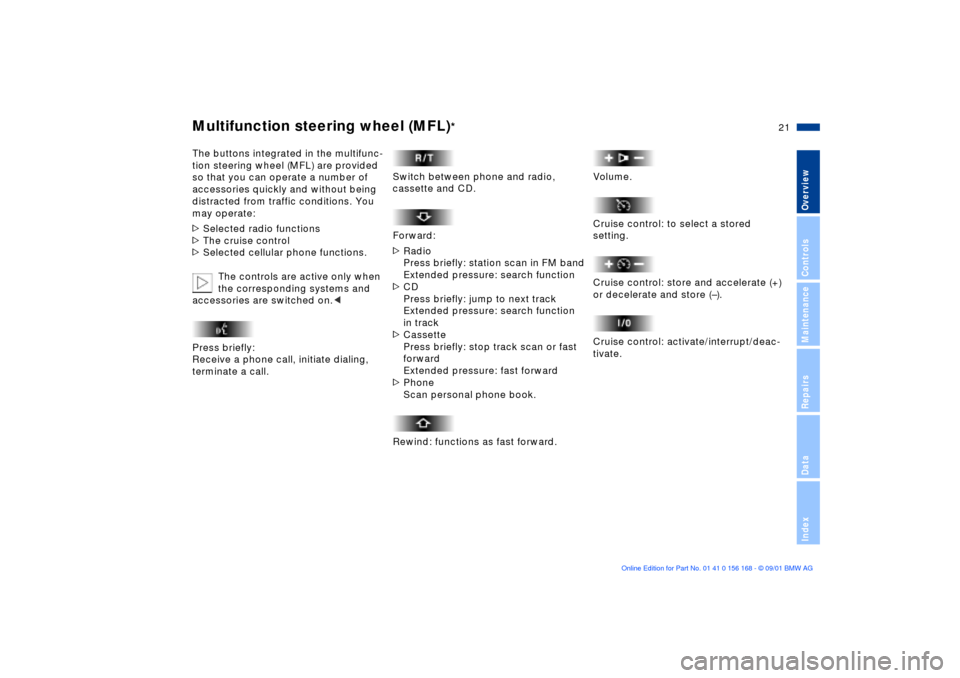
21n
OverviewControlsMaintenanceRepairsDataIndex
Multifunction steering wheel (MFL)
*
The buttons integrated in the multifunc-
tion steering wheel (MFL) are provided
so that you can operate a number of
accessories quickly and without being
distracted from traffic conditions. You
may operate:
>
Selected radio functions
>
The cruise control
>
Selected cellular phone functions.
The controls are active only when
the corresponding systems and
accessories are switched on.
<
Press briefly:
Receive a phone call, initiate dialing,
terminate a call.
Switch between phone and radio,
cassette and CD.
Forward:
>
Radio
Press briefly: station scan in FM band
Extended pressure: search function
>
CD
Press briefly: jump to next track
Extended pressure: search function
in track
>
Cassette
Press briefly: stop track scan or fast
forward
Extended pressure: fast forward
>
Phone
Scan personal phone book.
Rewind: functions as fast forward.
Volume.
Cruise control: to select a stored
setting.
Cruise control: store and accelerate (+)
or decelerate and store (Ð).
Cruise control: activate/interrupt/deac-
tivate.
Page 22 of 155
22n
Hazard warning triangle
*
Refueling
The hazard warning triangle is stored in
a storage case on the left side of the
luggage compartment.
Always observe all legal regula-
tions requiring a warning triangle
to be carried in the vehicle.
<
Fuel filler door
Always switch off the engine
before refueling, as it is not
possible to add fuel with the engine
running, and attempts may also trigger
the SERVICE ENGINE SOON lamp.<
Press on the rear edge of the fuel filler
door to open and close it.
If an electrical malfunction occurs, you
can unlock the fuel filler door manually:
1. Unlock the trim panel on the right
side of the luggage compartment
2. Pull the button with the fuel pump
symbol.
Always observe all safety precau-
tions posted at the service station
when handling fuel.
Never carry spare fuel containers in
your vehicle. Whether empty or full,
these containers can leak, cause an
explosion, or lead to fire in the event of
a collision.<
Page 23 of 155

23n
OverviewControlsMaintenanceRepairsDataIndex
Refueling Fuel specificationsSimple and environmentally
friendly
Open the filler cap carefully to
prevent fuel from spraying out.
Fuel spray may cause injury.<
Keep the filler cap in the bracket (arrow)
attached to the fuel filler door.
When refueling, insert the filler nozzle
all the way into the filler pipe. Pulling
the nozzle out of the pipe during refu-
eling
>results in premature pump shutoff
>and will reduce the effectiveness of
the vapor recovery system on the
pump.
As long as the filler nozzle is used prop-
erly, the fuel tank is full whenever the
nozzle shuts off the first time.
Refill early to avoid damaging the
catalytic converter; never attempt
to drive to the last drop of fuel in the
tank.<
Close the fuel cap carefully after
refueling until a click is heard.
While closing, be sure not to squeeze
the strap which is fastened to the cap.
A loose or missing cap will activate the
CHECK FILLER CAP lamp
* or the
SERVICE ENGINE SOON lamp.<
Tank capacity: approx. 16.6 gal.
(63 liters), incl. a reserve capacity of
approx. 2.1 gal. (8 liters).
The engine uses lead-free gasoline
only.
Required fuel:
>Premium Unleaded Gasoline,
min. 91 AKI.
AKI = Anti Knock Index
Never use leaded fuel, as it would
cause permanent and irreversible
damage to the oxygen sensor and the
catalytic converter.<
Page 24 of 155

24n
Tire inflation pressures The specified inflation pressures are
provided on a sticker attached to the
B-pillar and visible with the driver's
door open.Checking tire pressuresAll tire pressure and ambient air
temperature specifications are stated in
the units usually used in your country
(psi; kilopascal) (refer also the following
tire inflation pressures table).
Vehicles with Tire Pressure Monitor
(RDC)/Flat Tire Monitor:
After correcting the inflation pressures,
reactivate the system, refer to
pages 78, 80.
Another instruction plate regarding
inflation pressures on the door pillar
indicates which system is equipped on
your vehicle.
Check tire pressures on a regular
basis Ð at least twice a month Ð
and before every extended journey.
Otherwise, incorrect tire pressure can
lead to poor handling, to tire damage
and accidents.
Remember to check the inflation pres-
sure in the space-saver or standard
spare tire.
Inflate the spare tire to the highest infla-
tion pressure of any tire on your
vehicle.<
Comply with tire approval
specificationsThe inflation pressures in the table
apply to BMW approved tire sizes and
tire manufacturers. Your BMW center is
familiar with these pressures. Higher
pressures may be specified for tires
made by other manufacturers.
Your vehicle is equipped with tires that
not only meet US standards, but also
European standards. We recommend
the exclusive use of BMW approved
tires.
 1
1 2
2 3
3 4
4 5
5 6
6 7
7 8
8 9
9 10
10 11
11 12
12 13
13 14
14 15
15 16
16 17
17 18
18 19
19 20
20 21
21 22
22 23
23 24
24 25
25 26
26 27
27 28
28 29
29 30
30 31
31 32
32 33
33 34
34 35
35 36
36 37
37 38
38 39
39 40
40 41
41 42
42 43
43 44
44 45
45 46
46 47
47 48
48 49
49 50
50 51
51 52
52 53
53 54
54 55
55 56
56 57
57 58
58 59
59 60
60 61
61 62
62 63
63 64
64 65
65 66
66 67
67 68
68 69
69 70
70 71
71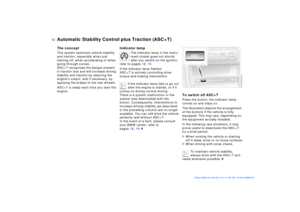 72
72 73
73 74
74 75
75 76
76 77
77 78
78 79
79 80
80 81
81 82
82 83
83 84
84 85
85 86
86 87
87 88
88 89
89 90
90 91
91 92
92 93
93 94
94 95
95 96
96 97
97 98
98 99
99 100
100 101
101 102
102 103
103 104
104 105
105 106
106 107
107 108
108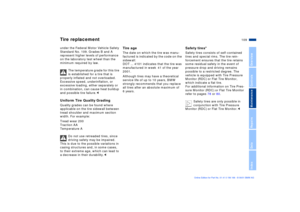 109
109 110
110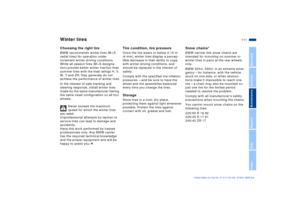 111
111 112
112 113
113 114
114 115
115 116
116 117
117 118
118 119
119 120
120 121
121 122
122 123
123 124
124 125
125 126
126 127
127 128
128 129
129 130
130 131
131 132
132 133
133 134
134 135
135 136
136 137
137 138
138 139
139 140
140 141
141 142
142 143
143 144
144 145
145 146
146 147
147 148
148 149
149 150
150 151
151 152
152 153
153 154
154




